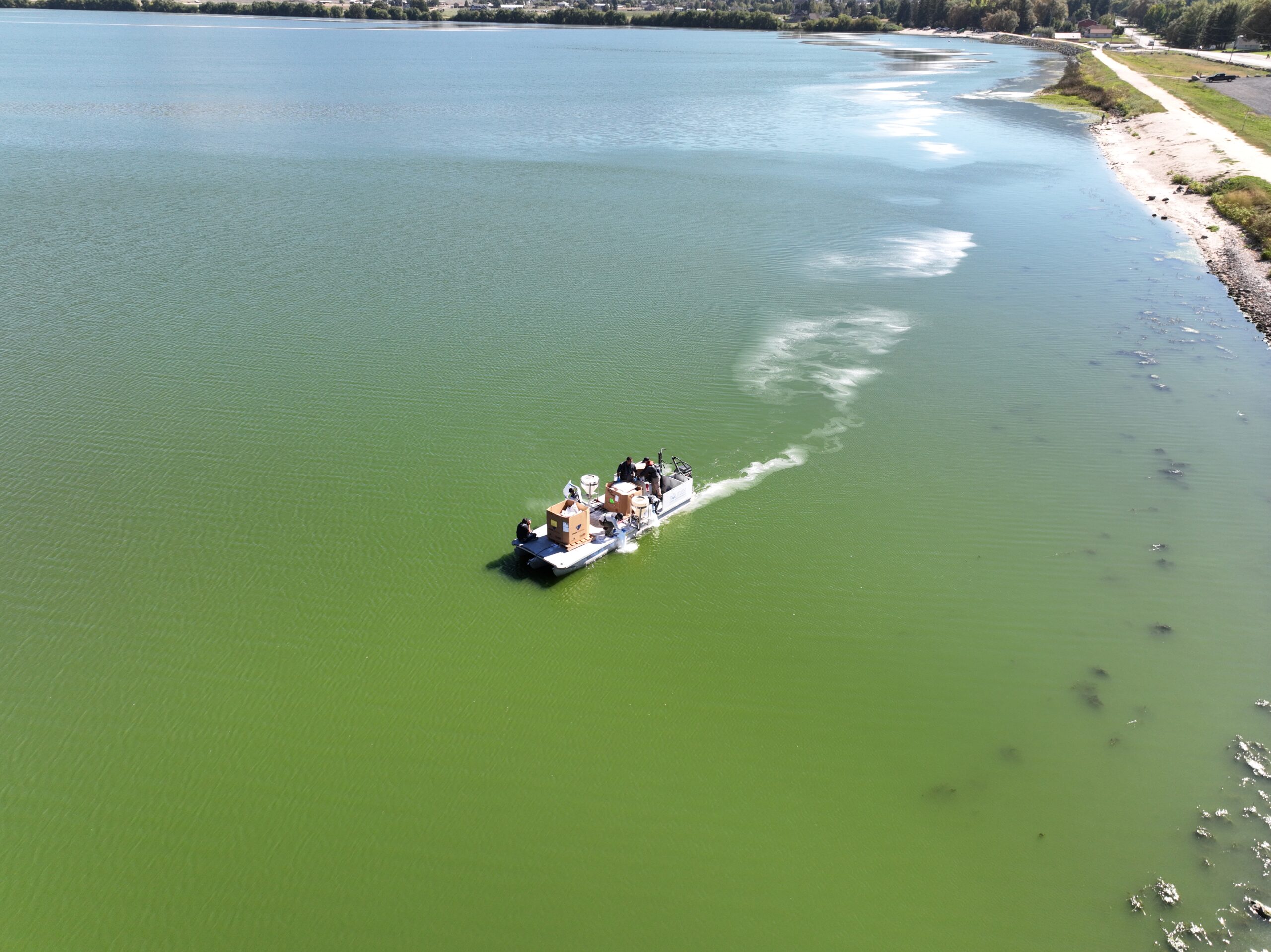A company called BlueGreen Water Technologies aims to remove carbon dioxide from the atmosphere while also fighting algae’s toxic effects on people and the environment
Freelance writer
In September 2023, Moshe Harel watched the waters of Mantua Reservoir, a lake that supplied water to Brigham City, Utah, turn from pea-green to a clear blue. The reservoir had been choked with cyanobacteria, leading to public health advisories that warned people not to touch or swim in the water and putting financial stress on the local public works department. But over the course of a single day, Harel and a team of workers poured bags of white powder into the water, killing the bacteria and letting local residents access the lake again.
Harel, who had earned his PhD in environmental microbiology, had always been fascinated by cyanobacteria and algae, wanting to understand what made them so successful in the environment—and how to stop them. In 2018, the company he founded, BlueGreen Water Technologies, began treating lakes in Israel, China, South Africa and the United States that were suffering from harmful algal blooms using a chemical mix he calls Lake Guard.
As Harel and his team spread Lake Guard in bodies of water around the world, he noticed that the cells that made up the harmful algal bloom were not just dying, but they were sinking into the sediment. That gave him an idea: Could they be taking carbon dioxide from the atmosphere with them? And could that carbon be measured and sold?
That concept is now being put to the test, as BlueGreen is popularizing the idea that treating harmful algal blooms can also be a form of carbon removal, which can help combat climate change. In April, the company announced that the project in Utah had removed nearly 13,000 metric tons of carbon dioxide equivalents, with an impact similar to taking 3,000 cars off the road for one year. BlueGreen is selling the removed carbon as “credits” to corporations seeking to offset their own carbon emissions, a market that’s growing larger as companies work to meet sustainability goals.
Nature-based carbon removal methods like BlueGreen’s, which take advantage of natural processes to sequester carbon rather than constructing large machines to suck it out of the air, are gaining popularity in this voluntary carbon market due to their relatively low cost and additional benefits, like improving soil health or treating ocean acidification. But BlueGreen’s technology is the first to remove carbon by also treating harmful algal blooms. And the company views selling carbon credits as a way to fund cleanups in places that normally couldn’t afford it, making the fight against algal blooms more accessible for public agencies, especially in countries outside the U.S.
“What we can do is not only remove and reduce greenhouse gases,” Harel says, but also make water safe. “There is a huge amount of work to do.”
Algae and bacteria are microorganisms that naturally occur in bodies of water and aren’t necessarily toxic. But under the right conditions, they can multiply rapidly, growing out of control and forming harmful algal blooms in lakes and in the ocean, where they’re often called “red tides.” Some of these, such as those created by cyanobacteria, can release toxins that threaten human health, causing allergic reactions, flu-like symptoms, and even liver poisoning and death. Others aren’t directly toxic but can consume all of the oxygen around them, causing a “dead zone” in the water and killing other organisms.
In response, researchers have developed numerous ways to try to deal with algal blooms, from spreading clay on them to releasing parasites that consume the algae. BlueGreen’s method uses hydrogen peroxide to trigger programmed cell death, which results when the bacteria experience oxidative stress. It’s like being hit with “small hammers on their head again and again,” Harel says. The hydrogen peroxide is released on the surface of the water and breaks down into water and oxygen, meaning it doesn’t continue to linger in the lake after killing the algae.
Using hydrogen peroxide to control algae is a tried-and-true method that other companies as well as researchers and government agencies have applied for decades, says Don Anderson, director of the U.S. National Office for Harmful Algal Blooms, supported by funding from the National Oceanic and Atmospheric Administration. BlueGreen’s formula releases the chemical over time, increasing its effectiveness on large algal blooms, according to a 2024 paper published in the International Journal of Environmental Research based on the company’s work in South Africa.
Though not all the algae stays buried in the sediment, the company has confirmed through sediment core sampling and modeling that between 23 and 45 percent will remain at the lake bottom for “thousands to millions of years,” Harel says. Anderson cautioned, however, that with potential disturbances from animals and unpredictable water levels hundreds of years down the line, that carbon could still eventually be released into the atmosphere. Carbon credits have faced criticism for their use in offsetting emissions, which opponents say prevents companies from reducing their greenhouse gas emissions, and some have been revealed to be not as long-lasting as they are claimed to be.
But at least for the time being, selling them has allowed BlueGreen to test its version of Lake Guard at Mantua Reservoir in Utah, which has struggled to deal with harmful algal blooms every year since 2017. The company cleaned up the water in 2023 at no cost to the city, thanks to the carbon credits it generated through the project, according to BlueGreen.
“Brigham City has spent countless staff hours testing and monitoring algal blooms over the last several years,” Tyler Pugsley, Brigham City’s public works director, told the Cache Valley Daily in September 2023. “These algal blooms have greatly affected recreational opportunities and limited our use of the reservoir.”
/https://tf-cmsv2-smithsonianmag-media.s3.amazonaws.com/filer_public/bb/01/bb018ec5-2096-466b-9d47-ae3573fe7819/setumo_5_before.jpeg)
/https://tf-cmsv2-smithsonianmag-media.s3.amazonaws.com/filer_public/22/a3/22a32405-1e08-4edc-8055-15a30ee288bf/setumo_5_after.jpeg)
Now, a research center in Florida is planning to test another Lake Guard formula, which uses aluminum sulfate rather than hydrogen peroxide, in Lake Jesup, a 16,000-acre lake in Seminole County that faces multiple harmful algal blooms each year. The project is being led by Emily Hall, a senior scientist at Mote Marine Laboratory and an expert on the issue who is hoping to begin testing in Lake Jesup in March, once she gets the go-ahead from Florida’s Department of Environmental Protection.
Hall’s goal is to understand how to mitigate harmful algal blooms without harming the ecosystem as a whole. Some substances that kill the algae can cause other kinds of bacteria to grow in the water instead. Others cause the algae to release all of the cyanotoxin within them when they die, poisoning fish and other organisms in the lake. And certain classes of chemicals work by getting rid of the algae’s food—but if too many nutrients are absorbed, useful algae and bacteria won’t be able to grow, causing a massive die-off.
Hall and her colleagues at the Mote Marine Laboratory are asking critical questions: How do these blooms die naturally? And are there any substances that already exist in nature and can clean up algal blooms without harming the environment? To find out, her team tests different compounds in the lab; if they see that one is successfully able to combat the algae, they then do experiments to measure its effects on the environment as a whole, including the chemistry of seawater and other marine organisms. Only then can they start doing field tests, which require obtaining a permit from state environmental authorities.
“Not every lake gets algal blooms, but some lakes, like Lake Jesup, are in dire straits,” Hall says. “We’re pushing a threshold [where] we need to figure out ways to solve these problems. This testing is good because it can give us a jump start to get the lake under control.”
After that, though, keeping Lake Jesup—and others around Florida and the U.S., as well as the ocean—free of blue-green algae or red tides means changing the way humans interact with the environment around these bodies of water, Hall says. For example, she advocates installing more “Florida-friendly landscaping” that incorporates plants already adapted to the local environment, which won’t require massive amounts of fertilizers to maintain. Sustainable farming practices, such as planting cover crops or reducing fertilizer use, will also prevent nutrient runoff from feeding the algal blooms, as would reducing the amount of land that’s covered in concrete and installing more green infrastructure that absorbs rainwater.
These practices will be especially important as climate change makes harmful algal blooms larger, more widespread and more likely to occur. Although many factors influence the blooms, a 2022 United Nations Intergovernmental Panel on Climate Change report noted that rising water temperatures create the perfect habitat for bacteria and algae, while increased levels of carbon dioxide in the air and water help feed them. Increased rainfall in places like the Midwestern U.S. is also encouraging more runoff to reach bodies of water like Lake Erie, which is experiencing earlier and longer-lasting algal blooms. One study from 2017 found that if current conditions continue, the average number of days that bodies of water around the U.S. would experience harmful algal blooms could triple by 2050.
“There won’t be a one-and-done solution,” Hall says. To truly address algal blooms, “we have to stop elevated levels of nutrients flowing into [lakes].”




